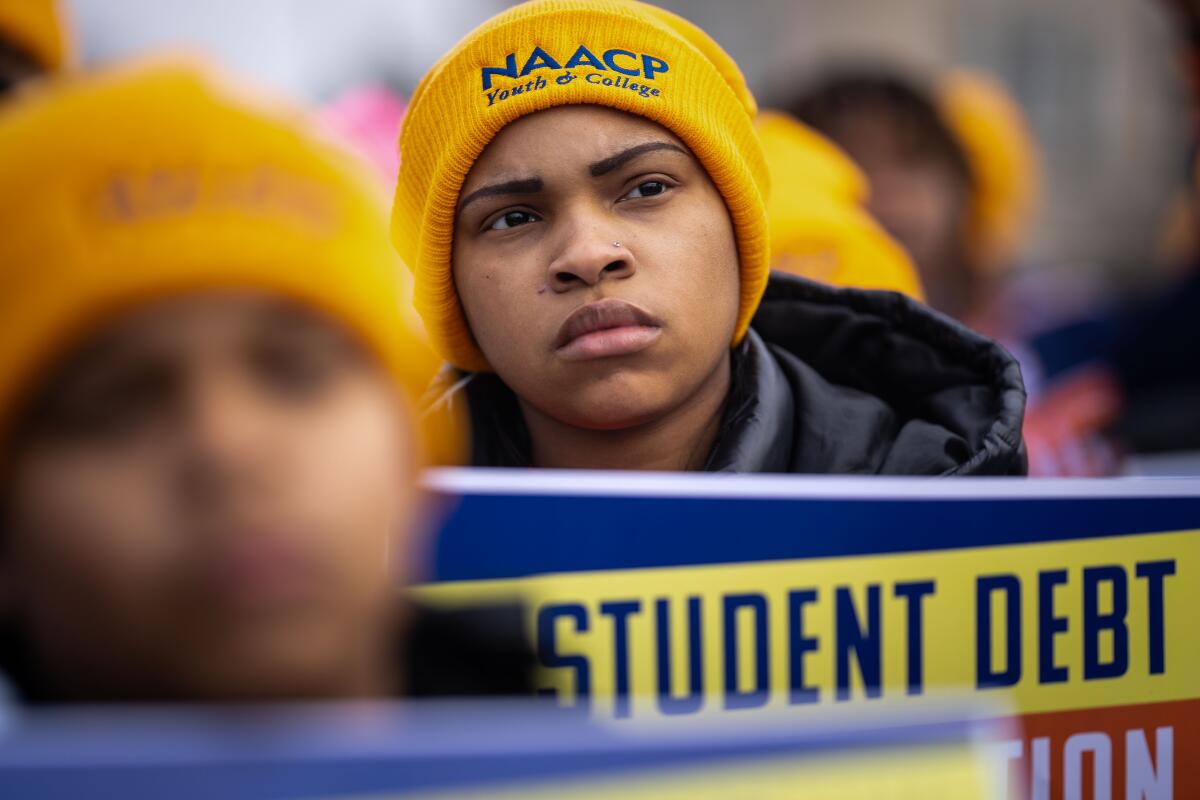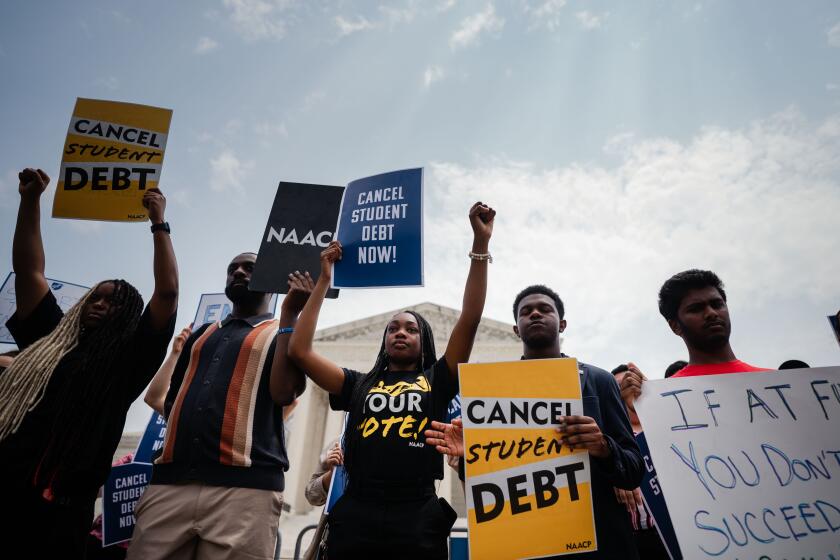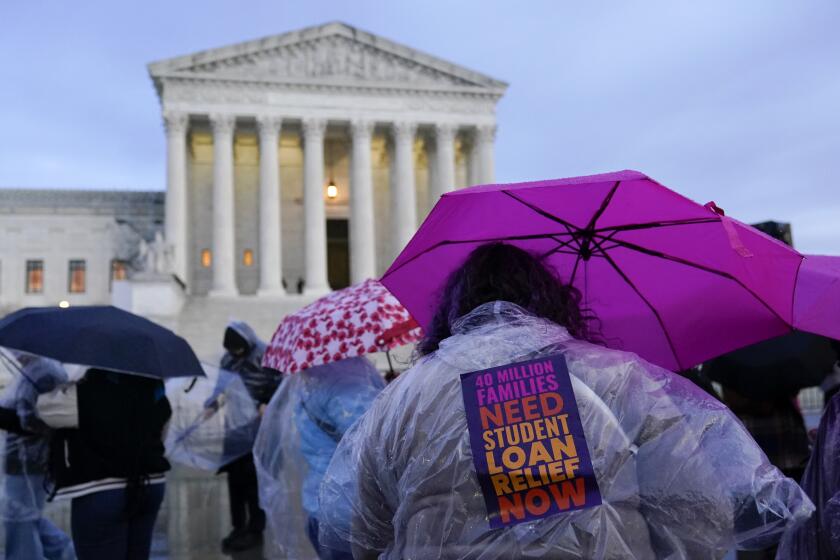Supreme Court’s student loan ruling dealt Biden a setback. Here’s his new plan

- Share via
WASHINGTON — When President Biden announced his plan to cancel up to $20,000 in federal student loans for some borrowers last August, he framed it as part of a multipronged approach to ease the burden on loan holders and prevent a wave of defaults.
Now, in the final months of the federal student loan repayment pause, it’s clear much of that safety net will not materialize.
The Supreme Court on Friday blocked Biden’s debt forgiveness plan, and his administration is still finalizing an overhaul of a program that allows borrowers to pay only a small portion of their discretionary income toward student loans. Several third-party companies contracted by the Department of Education to collect debts have laid off staff, cut call center hours or stopped handling student loans.
The Supreme Court has ruled that President Biden does not have the authority to forgive millions of student loans.
The Biden administration now faces an unprecedented task: helping tens of millions of borrowers make payments in a student loan system that’s been dormant for three years.
“Nothing like this has ever been attempted in the history of consumer finance,” said Cody Hounanian, executive director of the Student Debt Crisis Center, which advocates for debt cancellation. “It is a huge, monumental task that is going to face roadblocks and obstacles along the way.”
Federal student loan payments have been paused and interest has not accrued under a forbearance program that has been extended several times under former President Trump and Biden.
After several false starts, the Biden administration has been legally blocked from extending the payment suspension due to provisions in the deal he signed last month to raise the debt ceiling. Student loan interest will begin accruing on Sept. 1, and loan payments will be due starting in October.
Biden announced Friday that he will begin a new regulatory process to enact student debt relief under the 1965 Higher Education Act, a different law than the one he originally used.
Although the new path may take longer, Biden said he believed it was legally sound and “the best path that remains to provide for as many borrowers as possible.”
To ease borrowers into repayment, he said his administration is creating a temporary 12-month “on-ramp repayment program,” which he said was not the same as the repayment pause. He encouraged borrowers who can afford to pay their monthly bills to do so but said the new program would temporarily remove the threat of default or damage to borrowers’ credit.
“Today’s decision has closed one path,” the president said as he stood next to Education Secretary Miguel Cardona. “Now we’re going to pursue another.”
Borrower advocates and administration officials are bracing for a rocky return to repayment.
When Biden announced his student loan debt cancellation plan last year, he said, “By resuming student loan payments at the same time as we provide targeted relief, we’re taking an economically responsible course.”
Under the blocked plan, the Department of Education would have forgiven up to $10,000 in federal student loan debt for people making less than $125,000 a year, or $250,000 for married couples. People who received Pell Grants for low-income students would have been eligible for an additional $10,000. The administration estimated that nearly 40 million people would have qualified to have their debt reduced or eliminated by the proposal.
In addition to cancellation, Biden touted changes the administration was making to programs designed to help lower borrowers’ monthly payments or get their loans forgiven.
The biggest proposal is the Department of Education’s overhaul of one of its income-driven repayment programs. Under new proposed regulations released in January, the threshold for what counts as discretionary would be raised from income above 150% of the federal poverty level to 225%. Borrowers with undergraduate debt would owe just 5% of their discretionary income each month, down from 10%.
Individuals making less than $30,600 a year (or $62,400 in a family of four) would owe nothing each month on student loans. Borrowers whose monthly payments don’t cover accrued interest would have it waived.
The Congressional Budget Office estimated the plan would cost $230 billion over the next 10 years.
The plan will be finalized sometime this year, Undersecretary of Education James Kvaal told a House panel in May.
Opponents of the plan say that it may entice students to borrow more and encourage colleges to charge more in tuition.
Biden’s student loan policy has focused not on widespread cancellation but on improving the complex web of safety-net programs available to help borrowers, often by undoing policies implemented by Trump’s Education Department.
The Biden administration has approved tens of billions in loan cancellations for people who say they were defrauded by their colleges and made it easier for people who have permanent disabilities to discharge their loans.
The Education Department also has made it easier for people who work in public service or nonprofit work, such as teachers, nurses and social workers, to get their loans canceled through the Public Service Loan Forgiveness program. More than 615,000 public servants were approved for $42 billion in forgiveness through the program, the department announced in May.
For the record:
2:22 p.m. June 30, 2023An earlier version of this article reported that Americans hold a total of about $1.7 trillion in federal student loan debt. Americans hold $1.6 trillion in federal student debt.
But the bulk of federal student loan debt — about $1.6 trillion held by 43 million Americans — won’t be canceled anytime soon.
Without loan cancellation or a new income-driven repayment plan, many borrowers will return to a loan system nearly identical to the one that existed before the COVID-19 pandemic.
“I think of the payment pause as a tourniquet,” said Persis Yu, deputy executive director and managing counsel at the Student Borrower Protection Center. “The problem is you can’t just release a tourniquet; you have to actually do the repair. And we haven’t done that.”
A lot has changed for borrowers in three years. Some have moved and haven’t updated their contact information with their loan servicer. Some have new loan servicers. Some were behind on their loans before the repayment pause, while others have higher or lower incomes that will affect their monthly balances. Millions of borrowers who have graduated since 2020 will be making their first student loan payments later this year.
As the amount of student loan debt continues to grow, more and more borrowers are seeking alternative ways to get relief. But many companies promising to help are just trying to exploit borrowers’ desperation.
At the core of the student loan system predicament is the disparity between the size of the challenge and the resources available. The Federal Student Aid office received $800 million less than it requested from the government heading into this year, as Republicans in Congress blocked funding that could be used to implement loan cancellation. That has led to fewer resources for contracts with loan servicing companies, which have scaled back just as demand is about to explode.
Federal loan servicers such as Navient and Great Lakes have exited the student loan market and transferred their portfolios to other companies. About 44% of student loan holders will have to work with a new servicer when payments resume, according to a June report by the Consumer Finance Protection Bureau.
The loan repayment system wasn’t designed to handle millions of people returning to payment at the same time, said Scott Buchanan, executive director of the Student Loan Servicing Alliance, a trade association for organizations that service student loans. He encouraged borrowers to reach out to servicers now.
“If we can flatten the curve of demand on the student loan servicing environment by having people reach out in June, July and August … we can mitigate some of the pressures that are going to come to the system,” Buchanan said.
Biden reiterated Friday that he believed his student debt relief program would have benefited the economy, allowing Americans burdened with student debt to buy homes, launch businesses or start families. He called the high court’s decision to strike down his student debt relief program “a mistake” and said millions of other Americans were disappointed.
The president dismissed a question about whether he gave borrowers false hope.
“I didn’t give borrowers false hope. But the Republicans snatched away the hope that they were given and it’s real, real hope,” he said.
Asked if he overstepped his executive authority, Biden told reporters he thought “the court misinterpreted the Constitution.”
More to Read
Get the L.A. Times Politics newsletter
Deeply reported insights into legislation, politics and policy from Sacramento, Washington and beyond. In your inbox three times per week.
You may occasionally receive promotional content from the Los Angeles Times.














